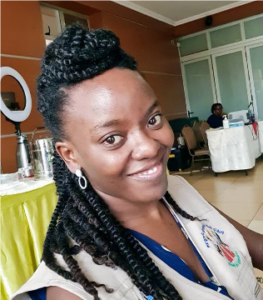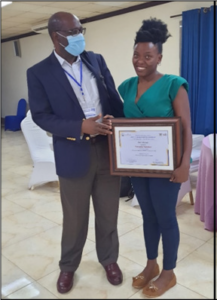 |
Petranilla NakamyaBHUN (MaK); MPH (MaK) |
|||
ABOUT THE FELLOWPetranilla Nakamya is a happy fully fledged field epidemiologist. She holds a master’s degree in public health with a background in pharmacy. She has particular interest in maternal and child health. During the fellowship Petranilla I was attached to the Public Health Emergency operation Centre (PHEOC), the information and coordination centre for public health events in Uganda. The training has empowered her with knowledge and skills in outbreak investigation and response, scientific writing and better knowledge on the public health system on Uganda. She served her country using the platforms granted. At the PHEOC, Petranilla was part of the team that enhanced capacities to manage and respond to the public health emergencies through strengthening the surveillance systems. She was involved in development of documents and systems that support surveillance. This training also exposed her broadening her outlook towards life and her network. Achievements at the Host Site
Fellowship program specific achievements
Written communication Manuscript: ‘Trends and geospatial distribution of stillbirths in Uganda, 2014-2020’. Newspaper article in the New Vision: ‘advice on the use of herbal medicines during the COVID-19 pandemic’ Edited the Issue 1 Volume 7 of the Uganda National Institute of Public Health epidemiological bulletin and published 3 articles in the same:
Published in the one health bulletin on Uganda Multi-Sectoral Self-Assessment, 2021 Conference presentations Presented at three national and one international conferences
Summary of Epidemiological Study:Background: Uganda has experienced three major waves of COVID-19 since March 2020, driven by the Alpha variant (wave 1; W1), Delta variant (wave 2; W2), and Omicron variant (wave 3; W3). We compared the epidemiology of cases across the three waves to inform decision-making in pandemic control Methods: We compared W3 cases to previously published results for W1 and W2 cases in Uganda. We collected medical records for 200 PCR-confirmed hospitalized patients (HP) from Entebbe and Mulago Referral Hospitals during W3 from December 2021 to February 2022. We interviewed by phone 200 randomly selected, PCR-confirmed non-hospitalized patients (NHPs) identified from lab records. Data on demographics, clinical characteristics, and vaccination status were collected from patients or next-of-kin (for fatal cases). Results: There was no difference in median age between patients in any wave. Among HP, the proportions female in W1, W2, and W3 were 27%, 46%, and 36%, respectively; all comparisons were significantly different (p<0.05). Among NHP, the proportions female in W1, W2, and W3 were 42%, 48%, and 43%, respectively, none significantly different. Among HP and NHP, the commonest comorbidity in all 3 waves was hypertension. W1, W2, and W3 had 18%, 28%, and 17% of HP with hypertension (significantly different between W3 and W2 (p=0.009) but not W3 and W1 (p=0.79)). There were no differences in the proportion of NHP with hypertension between any of the waves. No patients were vaccinated in W1. Among HP, more were fully vaccinated in W3 than W2 (46% vs 1%, p<0.001). Among HP, 6%, 26%, and 11% died in W1, W2, and W3, respectively, with W3 having significantly lower proportions of HP dying than W2 (p<0.001), but not W1 (p=0.073). Conclusion: The characteristics of HP and NHP with COVID-19 were modestly different in three COVID-19 waves in Uganda. Overall, W3 cases were somewhat more similar to those in W1 than W2. However, disease appeared to be less severe in W3 and W1 than W2. As the SARS-CoV-2 pandemic continues to evolve, monitoring waves and new variants should remain a priority to inform response. Key lessons learnt during the fellowship
|
||||
|
|

|
|
|


